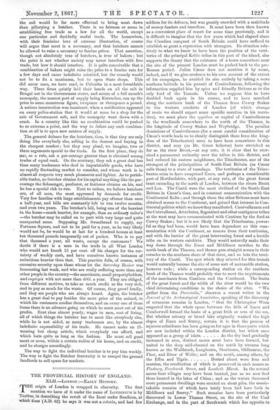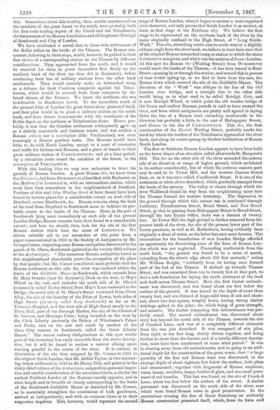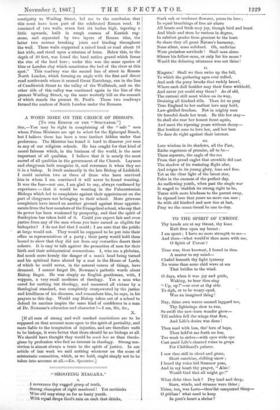THE PROVINCIAL HISTORY OF ENGLAND. XLH.—LONDON :—EARLY HISTORY.
THE origin of London is wrapped in obscurity. The first .JL mention we have of it under the name of LONDINIUM is by Tacitus, in describing the revolt of the Iceni under Boadicea, at which time (A.D. 62) he says it was not a colortia, and had few soldiers for its defence, but was greatly crowded with a multitude of money-lenders and travellers. It must have been then known as a convenient place of resort for some time previously, and it is difficult to imagine that the few years which had elapsed since the Claudian conquest of South Britain could have sufficed to establish so great a reputation with strangers. Its situation rela- tively to what we know to have been the position of the terri- tories of the principal Keltic tribes in this part of the island, also supports the theory that the existence of a town somewhere near the site of the present London must be pushed back to the pre- Boman period. Julius Cmsar does not mention it by name, indeed, and if we give credence to his own account of the extent of his campaigns, he avoided its site entirely by taking a more southern latitude in his pursuit of Cassivellaunus, following the information supplied him by spies and friendly Britons as to the only ford of the Tamesis. Unless we suppose him to have doubled back again in his course, and to have marched along the northern bank of the Thames from Cowes, Stakes to the western outskirts of London (of which change of route we should expect some specific mention in his narra- tive), we must place the oppidum or capital of Cassivellaunus in the woodlands somewhere to the north of the Thames, in the lobgitude of Cowey Stakes and Weybridge. The peculiar dominions of Cassivellaunus (for a more careful consideration of Ctesar's words leads us to clearly distinguish these from the king- dom of the Trinobantes) seem to have been somewhere in this district, and may (as Dr. Guest believes) have stretched as far as the river Brent,—at any rate, it is clear that he exer- cised a paramount authority over the tribes in this district, and bad reduced his eastern neighbours, the Trinobantes, one of the strongest of the principalities of South-East Britain (as Cgesar calls them) to a state of vassalage. The territories of the Trino- bantes seem to have comprised Essex, and perhaps a considerable part of Hertfordshire, with part, at any rate, of the great forest tract extending to the north of London, between the rivers Brent and Lea. The Cantu were the most civilized of the South-East Britons in Cgesar's time, and in constant communication with the Continental Kelts ; and through them the other Britons must have obtained access to the Continent, and gained that interest in Con- tinental politics which we knowthey manifested. Cassivellaunus and the Catevellauni, Attrebates, Segontiaci and other contiguous tribes at the west may have communicated with Cantium by the ford at Cowey Stakes ; but it is not likely that the Trinobantes, power- ful as they had been, would have been dependent on this com- munication with the Continent, so remote from their territories, and with the barrier of the great intervening forest and a hostile tribe on its western outskirts. They would naturally make their way down through the Essex and Middlesex marshes to the north bank of the Thames, and thence pass straight across in their coracles to the southern shore of that river, and so into the terri- tory of the Cantii. The spot which they selected for this transit would naturally become the site of some sort of mercantile station, however rude ; while a corresponding station on the southern bank of the Thames would probably rise to meet the requirements of the merchants from Cantium and the Continent. The limits of the great forest and the width of the river would be the two chief determining conditions in the choice of the sites. " We gather from the Parentalia," observes a recent writer in the Journal of the Archteological Association, speaking of the discovery of cetaceous remains in London, "that Sir Christopher Wren suspected that the whole space between the hills of Essex and Camberwell formed the basin of a great frith or arm of the sea. But whether estuary or broad lake originally washed the high slopes of Essex and Surrey, certain it is that the process of aqueous subsidence has been going on for ages in those parts which are now included within the London district, but which once
appeared as a group of islets As the dry land gradually increased in area, distinct meres must have been formed, but united to the deep mid-channel on the north by streams long known as the Wallbrook, Langbourn, Sherbourn, Oldbourne, the Fleet, and River of Wells ; and on the south, among others, by
the Effra and Tigris Dotted about were fens and marshes, the recollection of which is preserved in such names as Finsbury, Fenchurch Street, and Lambeth Marsh. In the several meres boat villages may have been located, just as we now find them located in the lakes of China ; and as the waters decreased more permanent dwellings were erected on stout piles, the unmis- takable remains of which have lately been laid bare both in Middlesex and Surrey." Such remains have been particularly discovered in Lower Thames Street, on the site of the Coal Exchange, and in the part of Southwark which lies opposite to
this. is. Somewhere about this locality, then, amidst marshes and on the outskirts of the great forest to the north, were probably built the first rude trading depOts of the Candi and the Trinobautes, the forerunners of the Roman Londinium and of the present Borough of Southwark and City of London.
We have attributed a coeval date to these twin settlements of the Keltic tribes on the banks of the Thames. The Roman con- querors, following in their steps, would, however, be guided in their first choice of a corresponding station on the Thames by different considerations. They approached from the south, and it would be essential for them to plant themselves first firmly on the southern bank of the river (as they did at Rochester), before continuing their line of military stations from the other bank northwards. They would scarcely make an intrenched camp as a defence for their Cantium conquests against the Trino- bantes, which would be severed from those conquests by the broad stream of the Thames. We know the northern site was indefensible in Boadicea's revolt. To the immediate north of the present City of London the great forest alone presented itself, and their plan would be to plant a military station on the south bank, and from thence *communicate with the merchants of the Keltic depot on the northern or Triuobantian shore. Hence, pro- bably, it was that the Cantian settlement subsequently giew up as a strictly mercantile and business resort, and was neither a Roman colonia nor a municipium (like Verulamium), nor even seemingly a Roman garrison town. The Romans would have little to do with North London, except as a mart of commerce and traffic for Britons and-Romans, and a place of transit to their great military station of C,kmuLonusium ; and at a later period, by a circuitous route round the outskirts of the forest, to the municipium of VERULAMIUM.
With this leading idea we may now endeavour to trace the growth, Of Roman London. A great Roman iter, we know from the hilieraries, led from DUROBRIVIS (identified with Rochester on the.Medway) to LONDINIUM, with an intermediate station, which must have been somewhere in the neighbourhood of Dartford. Portions of this road (the Watling Street of later times) have been traced in various places for a considerable extent on each side of Dartford, across Blackheath, &c. Roman remains along the back of the road from Deptford to Southwark seem to indicate its pro- bable course to the banks of the Thames. Here, in the part of Southwark lying more immediately on each side of the present London Bridge, Roman remains have been found to a considerable extent ; and here we should, then, look for the site of the first Roman station which bore the name of LONDINIUM. We obtain valuable aid in our researches at this point from a paper communicated in 1834 to the Society of Antiquaries by Mr. George Corner, respecting some Roman antiquities discovered in the parish of St. Olave, Southwark (printed in the twenty-fifth volume of the Archteologia). "The numerous Roman antiquities found in this neighbourhood abundantly prove the occupation of the place by that people ; but Mr. Corner considers it most probable that the Roman settlement on this side the river was confined within the limits of the Guildable Manor in Southwark, which extends from St. Mary Overies [now St. Saviour's] Dock on the west, to Hay's Wharf on the east, and includes the north side of St. Olave's (commonly called Tooley Street) from Hay's Lane westward to the Bridge, the south side of St. Olave's Street westward from Glean Alley, the site of the hostelry of the Prior of Lewes, both sides of High Street (formerly called Long Southwark) as far as St. Thomas's Hospital, and the west side of High Street nearly to the Town Hall, part of the Borough Market, the site of the Church of St. Saviour, and Montagu Close ; being bounded on the west by the Clink Liberty (anciently the Bishop of Winchester's Palace and Park), and on the east and south by another of the three City manors in Southwark, called the Great Liberty Manor." The recent railway disfigurations at this spot render part of this boundary less easily traceable from the above descrip- tion, but it will be found to enclose a narrow oblong space running parallel to the course of the river. It is curious, in illustration of the site thus assigned by Mr. Corner in 1831 to the original South London, that Mr. Arthur Taylor, in two interest- ing letters addressed in 1848 to Sir Henry Ellis, and printed in the thirty-third volume of the Arehteologia, assigns from personal inspec- tion and careful consideration of the ascertained facts, a site for the earliest Northern London of the Romans exactly opposite, and in river length and in breadth so closely corresponding to the limits of the Southwark Guildable Manor as described by Mr. Corner, as to materially strengthen the conclusions of both gentlemen, arrived at independently, and with no common views as to their respective inquiries. This, however, would represent the second stage of Roman London, when it began to assume a more organized civic character, and only proves that South London is as ancient, at least, as that stage in the Northern city. We believe the first stage to be represented on the southern bank of the river by the name originally confined to the High Street, of "Long South- Wark." This site, stretching north-east to south-west at a slightly oblique angle from the river bank, we believe to have been once that. of the original Roinan intrenched camp or station to which the name LONDINIUM was given, and which Was the nucleus of Roman London. At this spot the Roman iter (Watling Street) from DUROBRIVIS would reach the banks of the Thames,—it has been traced in Kent Street—passing by or through the station; and around this in process of time would spring up, as we find to have been the case, the Roman town which covered the site of the Guildable Manor. The direction of the " Work" was oblique to the line of the Okt London stone bridge, and a straight line to the other side would bring us to what used to be called Botolph Gate, and is now Botolph Wharf, at which point the old wooden bridge of the Saxon and earliest Norman periods is said to have crossed the river, and from which antiquaries are pretty well agreed in laying down the line of a Roman road extending northwards in the direction but probably a little to the east of Bishopsgate Street, and thence to the site of CAMVLODUNUM. This iter, the first. continuation of the Kentish Watling Sfreet, probably marks the track by which the trailers of the Trinobantes approached the river bank, and along its course sprang up the first habitations of Roman. North London.
The first or Southern Roman Loudon appears to have been built on the lower slopes of an elevation called afterwards St. Margaret's. Hill. The iter on the other side of the river ascended the eastern side of an elevation or range of higher ground, which undulated in its surface considerably, but of which the extreme eastern part may be said to be Tower Hill, and the western Cannon Street East, or, as it was once called, Candlewick Street. It is one of the eminences or islets above described, which gradually emerged from, the basin of the estuary. The valley or chasm through which the river Wallbrook found its way from the neighbouring Moor into. the Thames formed the western boundary. Thern depression in. the ground through which this stream ran is continued through Lothbury, Throckmorton Street, Broad Street, "and New Broad. Street, so that in passing from Bishopsgate Street to Broad Street,. through' the late Excise Office, there was a descent of twenty- feet. At Tower Hill the high ground is further removed from th& present bank of the river, the site of the present lower part of the. Tower precincts, as well as St. Katherine's, having evidently beew originally a sheet of water, as the latter has once more become. The excavations for the foundations of new London Bridge afforded an opportunity for discovering some of the lines of Roman Lon- don which was not neglected. Proceeding northwards from the- north bank, "the ground was found to be a mass of marsh, extending from the river's edge about 300 feet onwards," writes. Mr. William Knight, "evidently from its having once formed part of the bed of the Thames. It shelved up towards Thames Street, and was excavated from ten to twenty feet at that part, to find a safe foundation for laying the south abutment of the land arch built across Thames Street. Here the first timber embank- ment was discovered, and was found about ten feet below the surface of the ground. It was traced to the depth of more than. twenty feet, and was formed of huge solid trees of oak and chest- nut, about two feet square, roughly hewn, having strong timber waleings spiked to the piles ; the whole being of great strength,. and massive. The timber composing this intrenchment was per- fectly sound. The second embankment was discovered about, sixty feet beyond the north side of the 'Thames, towards the site of Crooked Lane, and was of a completely different character- from the one just described. It was composed of elm piles,. from eight to ten feet long, closely driven together, and being, further in shore than the former, and of a totally different descrip- tion, must have been constructed at some other period." It was. in clearing away these old embankments, and in going to an addi- tional depth for the construction of the great sewer, that "a large quantity of the fine red Roman ware _ was discovered, at the average depth of about eighteen feet lieloiv the surface, both plain and ornamented ; together with fragments of Roman amphorw, vases, tazzas, crucibles, lamps, bottles of glass, and one small pave- ment of red tessella3. This last was found on the site of Crooked Lane, about ten feet below the surface of the street. A similar pavement was discovered on the south side of the river, near which were found Roman coins in good preservation. In the excavations crossing the line of Great Eastcheap an evidently Roman construction presented itself, which, from ita form and
contiguity to Watling Street, led me to the conclusion that this must have been part of the celebrated Roman road. It consisted of two walls, seven feet six inches high, tapering a little upwards, built in rough courses of Kentish rag- stone, and separated by two layers of Roman tiles, the latter two courses breaking joists and binding throughout the wall. These walls supported a raised bank or road about 16 feet wide, and stood upon a stratum of loam. Below this, to the depth of 20 feet, was found the hard native gravel which forms the rise of the land here ; under this was the same species of blue or London clay which constitutes the bed of the river at this spot." This roadway was the second line of street in Roman North London, which forming an angle with the first and direct road northwards where it crowed Great Eastcheap, ran in the line of Candlewick Street to the valley of the Wallbrook, and on the other side of this valley was continued again in the line of the present Watling Street, up the more westerly hill on the summit of which stands the present St. Paul's. These two roadways formed the nucleus of North London under the Romans.
































 Previous page
Previous page